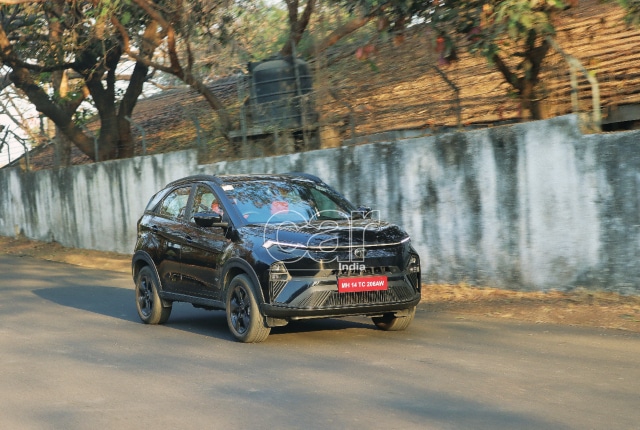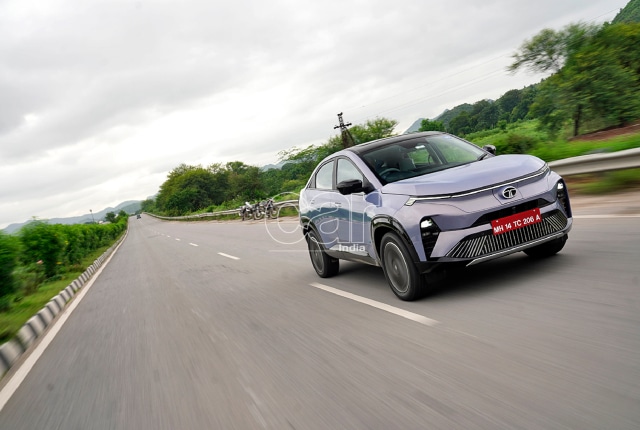 The Barons Bandhavgarh
The Barons Bandhavgarh
A royal welcome from a magnificent feline sets the mood for Car India’s sojourn into the big cats’ kingdom.
There comes a time in the life of every human being, a time of craving to return to the wild, to a life when man survived by instinct, braving the elements; a time to be free from the confines of concrete boxes and far away from the madding crowd. What happens to that instinct? Well, mostly it lies dormant, suppressed by the conveniences of what we call modern civilisation.
 Until a chance re-awakening.
Until a chance re-awakening.
It’s past 6.00 p.m. The gathering twilight and nimbus have conspired with the forest to create for us an impression of swimming through ink. Eyes straining and ears attuned to the twitter of the birds and every whirr of the cicadas as we drive the last few kilometres to Tala, we pass a herd of deer, statue-like, as they gaze into the inky dusk, noses a-twitch. We stop the Fortuner and begin taking pictures. A deer or two sips from the pond tentatively, returning frequently to follow the gaze of its clan.
The king is in the vicinity.
We scout the surroundings as best we can. No sign of the tiger. We can’t see it, but we know it’s there. That long-buried primal instinct is suddenly ticking again. Ensconced within our vault-like Toyota, none of us is brave enough to step out. After a few minutes of straining at the gloom, we decide to carry on. I crank the Fortuner to life and wince as the accompanying noise startles the deer. But barely have we driven a hundred yards when I feel a hand on my shoulder and a hushed voice asking me to stop. To our right, on a raised embankment parallel to the road, barely 30 feet away, sits a young male tiger. Completely disinterested, he just sits there. His absolute authority cannot be questioned. He is the king of all that he surveys. His benevolence stems from a sense of fearlessness (which, incidentally, has been his undoing). Yet somewhere, for a mere mortal, he re-kindles that wanderlust, that sense of true freedom, the will to be master of one’s domain. In a moment, we’ve travelled back in time, back to the time when we were wild.  Those few moments will live with each one of us forever. Shooed away by over-zealous forest guards shortly thereafter, we head to the quaint and cosy Nature Heritage resort to rest for the night. Dining in candlelight, the flickering shadows add to the atmosphere of the timeless images of tigers that adorn the walls. Our hotel enjoys the patronage of Kakubhai Kothari, a well-known photographer. Dinner table conversation centres round feline encounters and we have the pleasure of Rajvardhan Sharma’s company, who famously fought off a tigress some years ago.
Those few moments will live with each one of us forever. Shooed away by over-zealous forest guards shortly thereafter, we head to the quaint and cosy Nature Heritage resort to rest for the night. Dining in candlelight, the flickering shadows add to the atmosphere of the timeless images of tigers that adorn the walls. Our hotel enjoys the patronage of Kakubhai Kothari, a well-known photographer. Dinner table conversation centres round feline encounters and we have the pleasure of Rajvardhan Sharma’s company, who famously fought off a tigress some years ago.
With a belly full of country chicken and country brew, we trudge to our lodgings for a few hours of shut-eye. The sounds of the forest are a pleasant lullaby, even the persistent mosquito or two adding a second note to the tropical orchestra.
 We awake at a rude hour. We need to be at the gate of the Bandhavgarh Tiger Reserve before 5.00 a.m. As I step out to a fast-lightening sky, I’m struck by the freshness of the air, that early morning crispness, which is lacking even at the popular hill stations. The scents of the morning compete with the sounds of the previous evening for a sensory overdose.
We awake at a rude hour. We need to be at the gate of the Bandhavgarh Tiger Reserve before 5.00 a.m. As I step out to a fast-lightening sky, I’m struck by the freshness of the air, that early morning crispness, which is lacking even at the popular hill stations. The scents of the morning compete with the sounds of the previous evening for a sensory overdose.
The Fortuner glistens in the early morning sunlight, bejewelled with dew. We’re not the first to line up and we’re simply amazed by the number of tourists, many of whom have travelled from as far as Japan, Europe and America to see the magnificent beast. Tigers may be intrinsic to India, but tiger lore is all pervasive. Like humble subjects petitioning an audience with the king, we line up in an orderly queue.
At half-past-five, we drive into the Bandhavgarh Tiger Reserve. Within minutes, our guide points to the canal, which runs along the path. Right there, wonderfully camouflaged among the foliage is a young tigress with the most beautiful liquid eyes I have ever seen. Her demeanour is so much at odds with the devil-may-care bravado of the tiger we spotted yesterday. And soon we see why. Two young cubs, less than 10 months old, are resting nearby. 
 A few minutes spent admiring her and we move on. Later that same day, we spot another young tigress, this time with three cubs, near a watering hole. This time we stay longer, taking many more pictures.
A few minutes spent admiring her and we move on. Later that same day, we spot another young tigress, this time with three cubs, near a watering hole. This time we stay longer, taking many more pictures. We stay at Bandhavgarh for three days, even encountering the infamous Bokha, so named because he lost a canine in a brawl with another tiger, B2, since deceased. We spend most of the second day tracking Kalua (named because of his distinctive black markings), the enfant terrible who’s slowly asserting his position as the dominant male in Bandhavgarh. But Kalua has other plans. Forest guards report a sambhar kill, and the remains indicate a tiger that has eaten well. Sure enough, Kalua is asleep in his cave in a rocky gorge, cooled by the shade. I can see his paws, though, and by all indications, this is one large tiger. Kalua’s paws are all we get to see as the young tiger seems to like his 40 winks.
We stay at Bandhavgarh for three days, even encountering the infamous Bokha, so named because he lost a canine in a brawl with another tiger, B2, since deceased. We spend most of the second day tracking Kalua (named because of his distinctive black markings), the enfant terrible who’s slowly asserting his position as the dominant male in Bandhavgarh. But Kalua has other plans. Forest guards report a sambhar kill, and the remains indicate a tiger that has eaten well. Sure enough, Kalua is asleep in his cave in a rocky gorge, cooled by the shade. I can see his paws, though, and by all indications, this is one large tiger. Kalua’s paws are all we get to see as the young tiger seems to like his 40 winks.
Of course, the realities of our time mean we must bid adieu to Bandhavgarh and its feline legends, and it is with some reluctance that we leave. It’s been a magnificent holiday, by all accounts, but now we must head back to what we call ‘civilisation’, leaving Kalua, Bokha and others of their ilk to sun themselves on a rock, snooze in the scrub, frolic in the streams, mate by moonlight and feast on deer as is their wont. Truly, a royal life!
Story: Harmaan R A J Madon
Photography: Sanjay Raikar
Rajvardhan Sharma
Occupation: Hotelier Age: 44
Raj has always been a nature-lover. He, along with Navneet Agarwal and Deepak Talan, initiated a conservation programme in the Bandhavgarh tiger reserve and eventually formed TigerGuards of India. Excerpts:
 CI: When and why was TigerGuards founded?
CI: When and why was TigerGuards founded?
Raj: It began in the summer of 2006. We realised that the number of tigers in Bandhavgarh was decreasing rapidly. This led to the foundation of TigerGuards of India.
CI: Why just tigers? Why not other animals?
Raj: Tigers can survive only in a perfectly balanced ecosystem. Therefore, to conserve the tiger, one has to make sure that the other species are doing well too. So we work towards conservation of all animals with the focus on the tiger.
CI: What are the major reasons for the rapid decrease in the number of tigers?
Raj: Earlier, the major cause was poaching. Now, however, with the government and the media taking interest in the matter, poaching is no longer the major cause in Bandhavgarh. Today the major cause is revenge killing of tigers by the villagers. The ever-shrinking habitat of the wild cat is another reason.

CI: What is revenge killing and how can it be prevented?
Raj: Sometimes the tigers enter the villages in the vicinity of the reserve and prey on the villagers’ livestock, which is very important to the villagers, it being their source of income. The angry villagers then seek revenge by killing the tigers. This is called ‘revenge killing’.
CI: Please tell us about the steps taken to date by TigerGuards towards conservation.
Raj: We worked in a phased manner. In the first phase, we provided the workers with the necessary equipment, which included mosquito nets, ration boxes, umbrellas, raincoats and torches etc. We also donated 14 motorcycles and a Maruti Gypsy. In the second phase, we sought to educate the village children by taking them for safaris (for which the government does not charge an entry fee). As we saw it, awareness among the villagers would certainly help curb the rate of revenge killings. In the third phase, we are trying to provide compensation to villagers whose cattle were killed by tigers. CI: What can the ordinary citizen do to conserve the tiger?
CI: What can the ordinary citizen do to conserve the tiger?
Raj: One can do a lot. One can donate money (the record for which can be seen from time to time) or one can help us in educating the villagers. One can also help by just spreading the word for tiger conservation. By the way, we would also like to mention here that earlier foreigners were a major source of income for this cause. However, now, with the country’s economy booming, they ask us why Indians can’t make handsome donations. So, we actually need generous donations from Indians, especially the MNCs.
Karan Dugal
On a Dream and a Prayer…
When you are in tiger territory, you suddenly realize that the tiger is one of the most elusive of the big cats, for as you scan the vista with eyes wide open, you see the deer, the peacocks, the hare, the gaur (Indian bison), but not the tiger. And yet, you know that the predator is lurking around somewhere, may be just a few feet away from you, may be behind that tree, or lying low under that tall grass. Wide awake, but yet, dreaming! Dreaming that the magnificent beast will appear out of thin air, into the viewfinder of our Canons. Armed with the photo gear that Canon India had loaned us, each one of us was silently praying for ‘that great appearance’.
(As we had mentioned in our recent issues of Car India and Smart Photography, we had chosen very modest photo gear – gear that would be within the financial means of most photographers and tourists. If you are very serious about your wildlife photography, we suggest you opt for one or more of the following: EOS 1Ds Mark III, 1D Mark III, 1D Mark IV, or 5D mark II. Combine this with one or more of the following lenses: EF500mm f/4L IS USM, EF400mm f/4 DO IS USM, EF300mm f/2.8L IS USM, EF100-400mm f/4-5.6L IS USM, EF 70-200mm f/2.8L IS II USM. Or if you are more of a tourist and less of a photographer, there’s the Canon PowerShot SX 1 IS, SX 20 IS, and similar prosumer models to suit every pocket).

 It seems the Almighty heard our prayers. A passing Jeep driver informed us that a tigress with three cubs were at a nearby watering hole. A few quick gear changes and screeching tyres brought us right in front of the tigress with her three cubs in a little pond, about 50 feet from us. We were at a height and looking down at the pond. There were almost 10 other vehicles, all trying to inch in closer to get a better view of the tigers. The light this time was bright enough and we had our fill of photographing the lovely animals.
It seems the Almighty heard our prayers. A passing Jeep driver informed us that a tigress with three cubs were at a nearby watering hole. A few quick gear changes and screeching tyres brought us right in front of the tigress with her three cubs in a little pond, about 50 feet from us. We were at a height and looking down at the pond. There were almost 10 other vehicles, all trying to inch in closer to get a better view of the tigers. The light this time was bright enough and we had our fill of photographing the lovely animals.
 Mapping our drive
Mapping our drive
How does one really check how good is a GPS navigation device? Does going for a 1,300 km trip across two states without a map book, relying solely on the GPS device for directions, seem like a fare test? Well, that’s exactly what we did. We left the map book behind and embarked on the journey.
The national highways were all covered by the GPS. The device worked like a dream upto Indore. It’s after that we encountered a few issues. Some of the smaller roads were not covered as well as we would have liked. We almost lost our way in Damoh because a new road has been constructed, which was not covered, I’m sure that this will be fixed by a small upgrade. The user interface is fairly intuitive and can be picked up by anyone. Another aspect of the device we really liked was the fact that route recalculation takes place instantly. One can also find the ATM, petrol pumps, places to stay and eat along the way. Most of the places we had our meals at were found using the GPS. This one thing the GPS never went wrong with.
 Besides navigation the MapmyIndia ZX150 (the device we were using) could play audio, video and even view images, which is why it doubled up as our music player too, playing music from the SD card. Another great feature is that the device can double up as a Bluetooth hands-free, allowing one to receive and answer calls on the device itself, though we wish these feature could be used during navigation also. All in all, the device offers great value for money and is a must for anyone who
Besides navigation the MapmyIndia ZX150 (the device we were using) could play audio, video and even view images, which is why it doubled up as our music player too, playing music from the SD card. Another great feature is that the device can double up as a Bluetooth hands-free, allowing one to receive and answer calls on the device itself, though we wish these feature could be used during navigation also. All in all, the device offers great value for money and is a must for anyone who
loves travelling.
Karan Dugal
About Bandhavgarh
Bandhavgarh’s rugged topography is home to many other species, including some beautiful birds, sloth bears, deer, monkeys and a variety of snakes. There is a rustic feel to Bandhavgarh, an unapologetic throwback to the survival-of-the-fittest idiom, which many sanctuaries lack.
The reserve is spread over 400 square kilometres. Tiger Guards is an NGO that has taken a very different approach to conservation, focusing instead on reducing man-animal conflict, and making the villagers feel more a part of their natural heritage. In this sense, the lessons learned in Bandhavgarh will be applicable to other forest reserves around India.
There are plenty of resorts in and around Bandhavgarh with varying budgets, including five-star accommodation if you’re the lounge-by-the-pool type. Additionally, if you have deep pockets, you can book an exclusive day-long elephant safari for Rs. 25,000.
The nearest town with an ATM and petrol pump is Umaria, approximately 35 km from village Tala.






















Leave a Reply